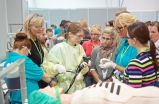(Press-News.org) Cosmologists have made the most sensitive and precise measurements yet of the polarization of the cosmic microwave background.
The report, published October 20 in the Astrophysical Journal, marks an early success for POLARBEAR, a collaboration of more than 70 scientists using a telescope high in Chile's Atacama desert designed to capture the universe's oldest light.
"It's a really important milestone," said Kam Arnold, the corresponding author of the report who has been working on the instrument for a decade. "We're in a new regime of more powerful, precision cosmology." Arnold is a research scientist at UC San Diego's Center for Astrophysics and Space Sciences and part of the cosmology group led by physics professor Brian Keating.
POLARBEAR measures remnant radiation from the Big Bang, which has cooled and stretched with the expansion of the universe to microwave lengths. This cosmic microwave background, the CMB, acts as an enormous backlight, illuminating the large-scale structure of the universe and carrying an imprint of cosmic history.
Arnold and many others have developed sensitive instruments called bolometers to measure this light. Arrayed in the telescope, the bolometers record the direction of the light's electrical field from multiple points in the sky.
"It's a map of all these little directions that the light's electric field is pointing," Arnold explained.
POLARBEAR has now mapped these angles with resolution on a scale of about 3 arcminutes, just one-tenth the diameter of the full moon..
The team found telling twists called B-modes in the patterns of polarization, signs that this cosmic backlight has been warped by intervening structures in the universe, including such mysteries as dark matter, composed of substance that remains unknown, and the famously aloof particles called neutrinos, which elude capture making them difficult to study.
This initial report, the result of the first season of observation, maps B-modes in three small patches of sky.
Dust in our own galaxy also emits polarized radiation like the CMB and has influenced other measurements. But these patches are relatively clean, Arnold says. And variations in the CMB polarization due to dust occur on so broad a scale that they do not significantly influence the finer resolution B-modes in this report.
"We are confident that these B-modes are cosmological rather than galactic in origin," Arnold said.
Observations continue, and the data stream will ultimately be fed by additional telescopes comprising the Simons Array. Together they will map wider swaths of the sky, making fundamental discoveries possible.
"POLARBEAR is a real tour de force. With a relatively small, but strong, UC-led team we have surpassed the next-nearest competitors by an order of magnitude in sensitivity. We have paved the way towards solving the deepest mysteries in the quest to understand matter and energy at the beginning of time," said Brian Keating.
POLARBEAR is a collaboration of scientists from many institutions including experiment founder, Adrian Lee, professor of physics at UC Berkeley.
INFORMATION:
The National Science Foundation provided major funding for the project to principal investigator Adrian Lee, and co-principal investigators William Holzapfel and Paul Richards at Berkeley, Nils Halvorsen at the University of Colorado Boulder, and Brian Keating at UC San Diego.
Funding for computing was provided by MEXT to investigators at the KEK Institute in Japan led by Masashi Hazumi and the U.S. Department of Energy to Lawrence Berkeley National Laboratory. Additional funding included support by the James B. Ax Family Foundation and the Simons Foundation.
The extinction in the wild of the southern white rhino population could be prevented by letting local communities take responsibility of the animals and giving them permission to harvest horns in a controlled manner through a legal trade. Rhino horn is made of the same material as human hair and fingernails and grows back in 2–3 years.
In 2013, more than 1000 rhinos were killed illegally for their horns in South Africa. Rhino horns are being used in Asia for traditional Chinese medicine and personal prestige. Now, a new study based on ecological and socio-economic ...
NASA's newest orbiter at Mars, MAVEN, took precautions to avoid harm from a dust-spewing comet that flew near Mars today and is studying the flyby's effects on the Red Planet's atmosphere.
The MAVEN spacecraft -- full name Mars Atmosphere and Volatile Evolution -- reported back to Earth in good health after about three hours of precautions against a possible collision with high-velocity dust particles released by comet C/2013 A1 Siding Spring.
"We're glad the spacecraft came through, we're excited to complete our observations of how the comet affects Mars, and we're ...
October 20, 2014 – (BRONX, NY) – Rates of depression and anxiety vary widely among different segments of the U.S. Hispanic and Latino population, with the highest prevalence of depressive symptoms in Puerto Ricans, according to a new report from Albert Einstein College of Medicine of Yeshiva University and the Hispanic Community Health Study/Study of Latinos (HCHS/SOL). The researchers' findings also suggest that depression and anxiety may be undertreated among Hispanics and Latinos, particularly if they are uninsured. The study was published online in Annals ...
Our species' waking and sleeping cycles – shaped in millions of years of evolution – have been turned upside down within a single century with the advent of electric lighting and airplanes. As a result, millions of people regularly disrupt their biological clocks – for example, shift workers and frequent flyers – and these have been known to be at high risk for such common metabolic diseases as obesity, diabetes and heart disease. A new study published in Cell, led by Weizmann Institute scientists, reveals for the first time that our biological clocks ...
Bethesda, MD (Oct. 21, 2014) — If you are not getting the recommended seven-to-eight hours of sleep each night, you may be at increased risk of developing ulcerative colitis, according to a new study1 in Clinical Gastroenterology and Hepatology, the official clinical practice journal of the American Gastroenterological Association.
"Both short and long durations of sleep have important health implications and are associated with increased overall mortality, cardiovascular disease and cancer," said lead study author Ashwin N. Ananthakrishnan, MD, MPH, Massachusetts ...
A team of UC San Francisco researchers has found that a tiny segment of genetic material known as a microRNA plays a central role in the transition from moderate drinking to binge drinking and other alcohol use disorders.
Previous research in the UCSF laboratory of Dorit Ron, PhD, Endowed Chair of Cell Biology of Addiction in Neurology, has demonstrated that the level of a protein known as brain-derived neurotrophic factor, or BDNF, is increased in the brain when alcohol consumed in moderation. In turn, experiments in Ron's lab have shown, BDNF prevents the development ...
(Vienna, October 21, 2014) Patients with irritable bowel syndrome (IBS) may at last be able to hope for a brighter future as innovative new treatments emerge and researchers clarify the role of current therapies. Dr Alexander C. Ford from the Leeds Gastroenterology Institute in Leeds, UK, tells journalists attending the 22nd United European Gastroenterology Week (UEG Week 2014) in Vienna, Austria, that significant progress was being made in drug development for IBS, thanks to the intense research efforts of scientists around the world. "Researchers have dedicated many years ...
A new study shows that survival and neurological outcomes for patients in cardiac arrest can be improved by adding extracorporeal membrane oxygenation (ECMO) when performing cardiopulmonary resuscitation (CPR). The study abstract was released today in an online supplement of the journal CHEST and will be presented at CHEST 2014, the annual meeting of the American College of Chest Physicians in Austin, Texas held October 25-30.
Despite advances in medical care, less than 20% of people who experience a cardiac arrest make a full recovery. An alternate approach to traditional ...
PROVIDENCE, R.I. [Brown University] — Scientists think of CD8 T cells as long-lived cells that become tuned to fight just one pathogen, but a new study finds that once CD8 T cells fight one pathogen, they also join the body's "innate" immune system, ready to answer the calls of the cytokine signals that are set off by a wide variety of infections.
Think of CD8 T cells as soldiers who are drafted and trained for a specific mission, but who stay in service, fighting a variety of enemies throughout a long career.
CD8 T cells therefore have more utility than researchers ...
Eliminating subsidies that help low- and moderate-income people purchase coverage through government-run health insurance marketplaces would sharply boost costs for consumers and cause more than 11 million Americans to lose their health insurance, according to a new RAND Corporation study.
Modeling the likely effects of ending subsidies offered to individuals under the federal Affordable Care Act, researchers found that such a move would increase premium costs in the individual marketplaces by as much as 43 percent and cause enrollment to drop by 68 percent.
"If subsidies ...


